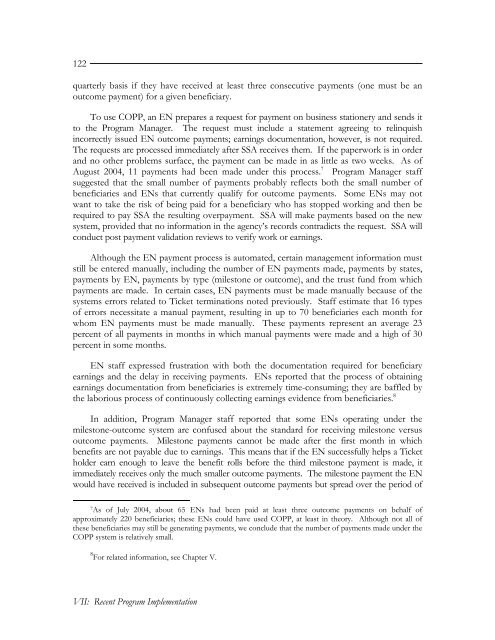Evaluation of the Ticket to Work Program, Implementation ...
Evaluation of the Ticket to Work Program, Implementation ...
Evaluation of the Ticket to Work Program, Implementation ...
Create successful ePaper yourself
Turn your PDF publications into a flip-book with our unique Google optimized e-Paper software.
122quarterly basis if <strong>the</strong>y have received at least three consecutive payments (one must be anoutcome payment) for a given beneficiary.To use COPP, an EN prepares a request for payment on business stationery and sends it<strong>to</strong> <strong>the</strong> <strong>Program</strong> Manager. The request must include a statement agreeing <strong>to</strong> relinquishincorrectly issued EN outcome payments; earnings documentation, however, is not required.The requests are processed immediately after SSA receives <strong>the</strong>m. If <strong>the</strong> paperwork is in orderand no o<strong>the</strong>r problems surface, <strong>the</strong> payment can be made in as little as two weeks. As <strong>of</strong>August 2004, 11 payments had been made under this process. 7 <strong>Program</strong> Manager staffsuggested that <strong>the</strong> small number <strong>of</strong> payments probably reflects both <strong>the</strong> small number <strong>of</strong>beneficiaries and ENs that currently qualify for outcome payments. Some ENs may notwant <strong>to</strong> take <strong>the</strong> risk <strong>of</strong> being paid for a beneficiary who has s<strong>to</strong>pped working and <strong>the</strong>n berequired <strong>to</strong> pay SSA <strong>the</strong> resulting overpayment. SSA will make payments based on <strong>the</strong> newsystem, provided that no information in <strong>the</strong> agency’s records contradicts <strong>the</strong> request. SSA willconduct post payment validation reviews <strong>to</strong> verify work or earnings.Although <strong>the</strong> EN payment process is au<strong>to</strong>mated, certain management information muststill be entered manually, including <strong>the</strong> number <strong>of</strong> EN payments made, payments by states,payments by EN, payments by type (miles<strong>to</strong>ne or outcome), and <strong>the</strong> trust fund from whichpayments are made. In certain cases, EN payments must be made manually because <strong>of</strong> <strong>the</strong>systems errors related <strong>to</strong> <strong>Ticket</strong> terminations noted previously. Staff estimate that 16 types<strong>of</strong> errors necessitate a manual payment, resulting in up <strong>to</strong> 70 beneficiaries each month forwhom EN payments must be made manually. These payments represent an average 23percent <strong>of</strong> all payments in months in which manual payments were made and a high <strong>of</strong> 30percent in some months.EN staff expressed frustration with both <strong>the</strong> documentation required for beneficiaryearnings and <strong>the</strong> delay in receiving payments. ENs reported that <strong>the</strong> process <strong>of</strong> obtainingearnings documentation from beneficiaries is extremely time-consuming; <strong>the</strong>y are baffled by<strong>the</strong> laborious process <strong>of</strong> continuously collecting earnings evidence from beneficiaries. 8In addition, <strong>Program</strong> Manager staff reported that some ENs operating under <strong>the</strong>miles<strong>to</strong>ne-outcome system are confused about <strong>the</strong> standard for receiving miles<strong>to</strong>ne versusoutcome payments. Miles<strong>to</strong>ne payments cannot be made after <strong>the</strong> first month in whichbenefits are not payable due <strong>to</strong> earnings. This means that if <strong>the</strong> EN successfully helps a <strong>Ticket</strong>holder earn enough <strong>to</strong> leave <strong>the</strong> benefit rolls before <strong>the</strong> third miles<strong>to</strong>ne payment is made, itimmediately receives only <strong>the</strong> much smaller outcome payments. The miles<strong>to</strong>ne payment <strong>the</strong> ENwould have received is included in subsequent outcome payments but spread over <strong>the</strong> period <strong>of</strong>7 As <strong>of</strong> July 2004, about 65 ENs had been paid at least three outcome payments on behalf <strong>of</strong>approximately 220 beneficiaries; <strong>the</strong>se ENs could have used COPP, at least in <strong>the</strong>ory. Although not all <strong>of</strong><strong>the</strong>se beneficiaries may still be generating payments, we conclude that <strong>the</strong> number <strong>of</strong> payments made under <strong>the</strong>COPP system is relatively small.8 For related information, see Chapter V.VII: Recent <strong>Program</strong> <strong>Implementation</strong>
















